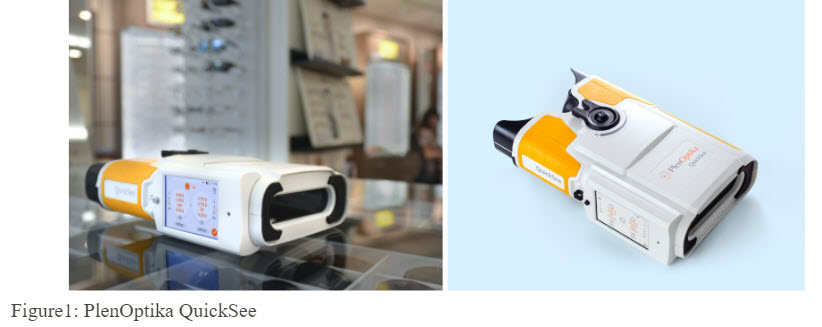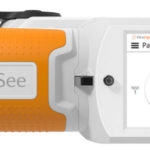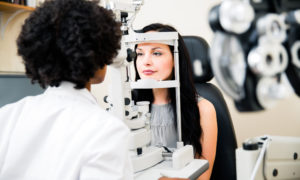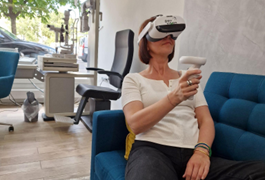This is the first article of a newly launched channel in Review of Optometric Business, Tech Review. Each quarter, we will publish a review by the New England College of Optometry Innovation Center under the direction of Gary Y. Chu, OD, MPH, FAAO, Vice-President, Professional Affairs, at NECO. The reviews will focus solely on products new to market, which Dr. Chu and his colleagues at NECO have personally learned about, and, in some cases, trialed in the college’s eyecare clinic.
PlenOptika QuickSee (QS)
PlenOptika’s QuickSee (QS) was conceived at MIT’s M+Visión Fellowship program1 (now MIT LinQ), which brings together researchers from various fields to tackle difficult global health issues. The program challenges their fellows to evaluate problems from different perspectives and to develop appropriate technical solutions that will have a tangible impact on society. In 2011, four PhD researchers with backgrounds in optics, biomedical engineering, medical imaging and physics formed Team Eye2 (which evolved into a company, PlenOptika) to address the problem of uncorrected refractive error in developing countries. They focused their research on fully understanding the process of refraction. Their solution was to develop a durable, portable, reliable, fast autorefractor to be used in low-resource communities comparable in accuracy and speed to autorefractors used in high-resource practices.3
Overview of the Technology
PlenOptika is a handheld wavefront aberrometer that has gone through several iterations to make it a functional clinical autorefractor. The founders’ core values of scientific integrity, applicability in real-world situations and evidenced-based results continue to drive the development of their product. Not only did they design the technology of their device, but they also partnered with established eyecare institutions including Aravind Eye Hospital, Wilmer Eye Institute and the New England College of Optometry to validate and evaluate the instrument in clinical settings.4 Funded by their success in innovation competitions, awards of federal and private grants and by the support of friends and family, their work was studied by their collaborators as well as other independent sources, resulting in peer-reviewed articles of the QuickSee’s performance.

The current version of the QuickSee is an open-view, binocular, durable and rechargeable handheld wavefront aberrometer that uses lower-order wavefront measurements to measure refractive error. The instrument takes simultaneous binocular measurements, but can also be used monocularly for asymmetric faces and strabismic patients. It weighs just over three pounds and is FDA-approved as a Class 1 Medical Device.5
In published papers, the QuickSee has been called the most accurate handheld autorefractor and comparable to a desktop autorefractor.6, 7 In low-resource communities, glasses prescribed from the QuickSee autorefraction are on par with glasses prescribed from a subjective refraction.7, 8, 9 For high-resource practices, that result translates to an excellent starting point for a subjective refraction.
What ODs & Their Staffs Think
Feedback to the company from ODs and their staff extolled the flexibility, accuracy and speed of taking measurements, as well as its ease of operation. Having a similar appearance to a pair of binoculars, patients intuitively find it simple and comfortable to hold during the test.
For patients with limited mobility, measurements can be taken in any position, including supine. In addition, the device has an open-view design, which allows the examiner to choose the appropriate external target for the patient. The battery charge typically lasts an entire day. Results are automatically printed on a self-contained printer, however, they are not wirelessly transferred to an electronic medical record.
Flexibility in Use of the Device
The portability of the QuickSee is its greatest asset because it allows creativity in the way an optometrist can utilize the instrument. It has obvious advantages in refracting wheelchair-bound patients or for bedside examinations, especially in nursing home and home care practices. Outside the office setting, ODs have also used it for pediatric screenings and on mission trips, and commented how it has increased efficiency and productivity in those settings.
During the pandemic, the QuickSee has allowed eyecare practices to experiment in providing socially-distanced refractions. This flexibility fosters thinking-outside-the-box as we continually evolve the practice of eyecare.
Final Thoughts
The QuickSee from PlenOptika had its genesis as a global health initiative for low-resource communities. This cost-effective, accurate, hand-held autorefractor has achieved its goal and is used in many under-served communities around the world. High-resource practices are now starting to adopt this device as an alternative to fixed-based autorefractors, but there are some improvements that still need to be made for widespread acceptance. For example, the integration of the refractive results into a practice’s EHR will improve efficiency and minimize errors in transfer.
PlenOptika has spawned many studies on the accuracy of the QuickSee. However, there have not been any studies looking at near refraction, workflow integration of their device, nor evaluations on how the QuickSee may be used in telemedicine. Such studies can help determine how portable devices can be adopted into practice to improve and enhance the care of patients.
Since the QuickSee is an open-view autorefractor, it may have applicability in clinical research studies. Currently, the gold standard for any clinical refractive study requires an objective refraction using an open-view autorefractor. That has limited clinical testing sites to institutions that can afford contemporary, expensive, open-view autorefractors. PlenOptika has an opportunity to help expand the number of clinical trial sites with the affordability of this device.
Clearly, there is value for this device to be used in both low- and high-resource communities.
Characteristics of the QuickSee
• Open view
• binocular – simultaneous measurements. Can also be used monocularly for asymmetric faces, strabismus patients
• Portable and handheld
• Lightweight
• Durable, rechargeable
• Can be used in lighted rooms
• Affordable
• FDA approved
Other Articles to Explore
Field Test Results of QuickSee
• Average time to take measurement, 3 min 11 sec
• Straightforward training for operator and patient
• Comfortable, not heavy
• Good battery life
• No need to connect with computer to take measurements, everything on the device
• Can be used in wheelchair and supine
• Accurate starting point for subjective refraction
References
1. https://linq.mit.edu/, accessed 3/1/2022
2. Team Eye, http://mvisionconsortium.org/portfolio-item/team-eye/, accessed 3/1/2022,
3. From M+Visión to Reality: PlenOptika – https://linq.mit.edu/from-mvision-to-reality-plenoptika/, accessed 3/1/2022
4. https://plenoptika.com/publications, accessed 3/1/2022
5. Gil A, Hernandez CS, et al, Assessment of the QuickSee wavefront autorefractor for characterizing refractive error in school-age children, PLoS ONE 15(10): e0240933
6. Ahhyun Stephanie Nam, Varshini Varadaraj, Alyssa Marie Kretz, Kanza Aziz, Marcos Rubio, Andrea Gil, Daryl Lim, Shivang Dave, David S Friedman, Nicholas J. Durr, Eduardo Lage; Assessment of wavefront measurements from a low-cost, portable, aberrometry-based autorefractor. Invest. Ophthalmol. Vis. Sci. 2020;61(7):531
7. Agarwal A, Bloom DE, deLuise VP, Lubet A, Murali K, Sastry SM (2019) Comparing low-cost handheld autorefractors: A practical approach to measuring refraction in low-resource settings. PLoS ONE 14(10): e0219501
8. Durr NJ, Dave SR, Lim D, et al. Quality of eyeglass prescriptions from a low-cost wavefront autorefractor evaluated in rural India: results of a 708-participant field study. BMJ Open Ophthalmology 2019;4:e000225
9. Rubio, Marcos, et al. “Validation of an Affordable Handheld Wavefront Autorefractor” Optom. Vis. Sci., vol. 96, no. 10, pp. 726–732, Oct. 2019
 Gary Y. Chu, OD, MPH, FAAO, is Vice-President, Professional Affairs, at New England College of Optometry. and the direction of the NECO Innovation Center. To contact him: chu@neco.edu
Gary Y. Chu, OD, MPH, FAAO, is Vice-President, Professional Affairs, at New England College of Optometry. and the direction of the NECO Innovation Center. To contact him: chu@neco.edu




























